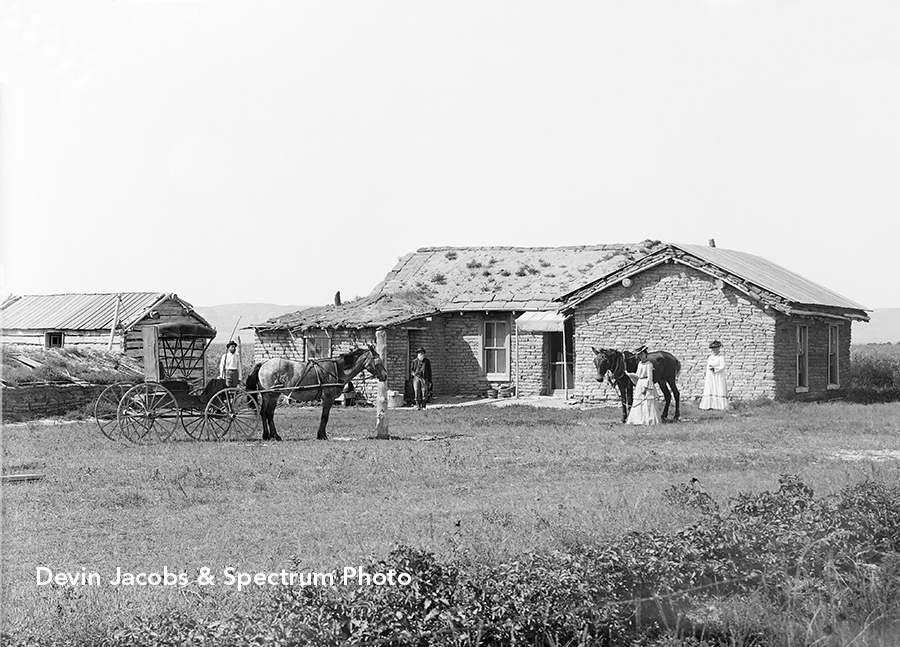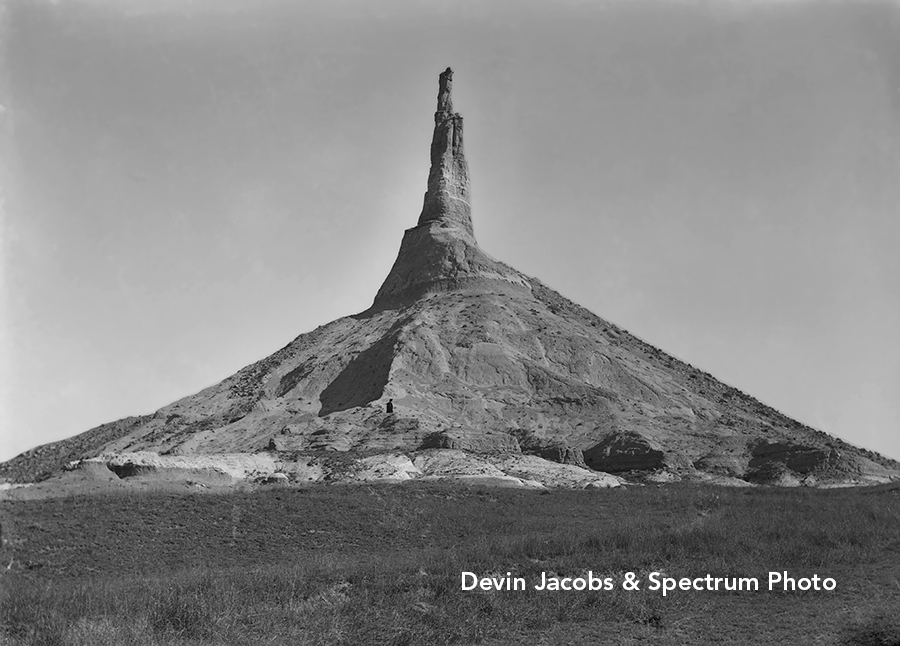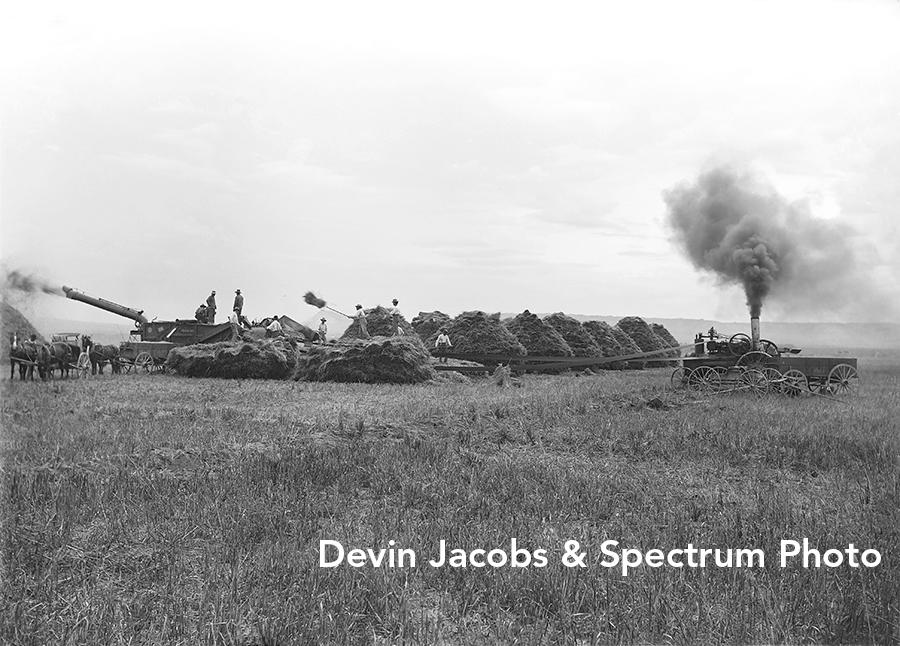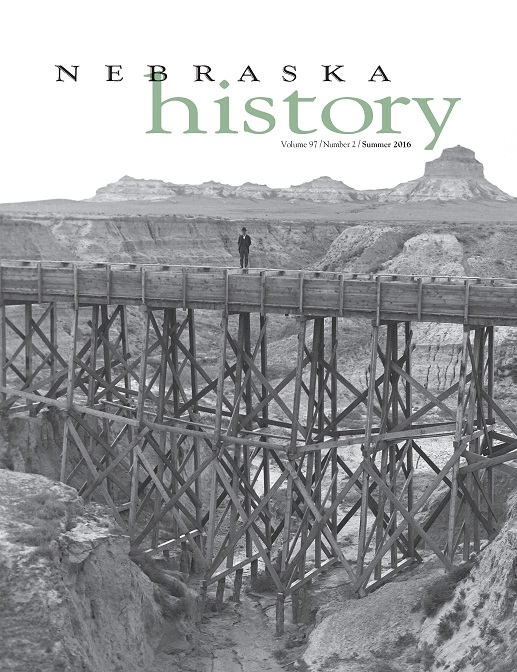 The right portion of this house shows a remnant of an earlier, lower gable, indicating that the house was originally built with a low roof (like the house in the left background in the previous photo). With its additions, awning, and partial new roof, the tidy sod house is the picture of prosperity.
The right portion of this house shows a remnant of an earlier, lower gable, indicating that the house was originally built with a low roof (like the house in the left background in the previous photo). With its additions, awning, and partial new roof, the tidy sod house is the picture of prosperity.
A Scottsbluff man was browsing an estate sale in 2014 when he noticed a box full of glass plate photographic negatives. Many were broken, but twenty-six were whole and contained recognizable views of local landmarks. He bought the box, and in so doing rescued some of the work of C. W. Bonham, one of the Panhandle’s most important early photographers.
Dating to the late nineteenth and early twentieth century, the photos are some of the finest early views of the North Platte Valley in the Scottsbluff-Gering vicinity. What is more, they document a crucial moment in the valley’s history: the beginning of large-scale irrigation projects that would soon transform the region’s economy.
The purchaser of the negatives, Devin Jacobs, had them scanned and corrected by Ken Kurtz of Spectrum Photo in Gering, then sold the negatives to Jack Preston of the Legacy of the Plains Museum in Gering. All parties approved the publication of these photos in Nebraska History. All photos in this blog post are by C. W. Bonham; digital images provided by Ken Kurtz, Spectrum Photo, Gering. Many of the images were printed as picture postcards in the early 1900s; reproductions of the postcards have occasionally been republished in books and articles. We believe, however, that this is the first time the photos have been published as a group, and the first time in more than a century that the images come directly from the original glass plates.
Clarence W. Bonham (1867-1934) was a businessman and professional photographer in Gering. His father, Rev. J. W. Bonham, M.D., was both a physician and an Episcopalian minister in New York City; his mother, Anna, was involved in the Woman’s Christian Temperance Movement and other moral crusades. But the Bonhams separated and in 1885 Anna moved to Cheyenne, Wyoming, relocating to western Nebraska in 1886. She claimed a homestead in Carter Canyon in southern Scotts Bluff County. When she was still “holding down her homestead” three years later, the Gering Courier remarked that the sixty-year-old “deserves a lot of credit for an old lady.”[1]
Clarence apparently came west with his mother; he was living in the area at least by January 1888. He claimed a homestead five miles west of Gering, became involved in the community, and married in 1890.[2]
 Chimney Rock has eroded over the years. The shape shown here matches that in photos known to be from the early 1900s
Chimney Rock has eroded over the years. The shape shown here matches that in photos known to be from the early 1900s
Although some sources identify C. W. Bonham primarily as a photographer, he listed his occupation as “confectioner” in the 1900 U.S. Federal Census. He and his wife, Nettie, never had children of their own, but Gering children of the day had fond memories of Mr. Bonham, who “made the world’s best ice cream in a child’s mind,” according to a woman quoted in a local history. Another Gering resident remembered riding with his father in a horse and buggy to deliver milk to Bonham’s creamery on the south side of town. Mr. Bonham “would give me a dip of ice cream with a big soup ladle.”[3]
Bonham was a man of diverse interests. His ice cream parlor and photography studio shared a building on Tenth Street.[4] Bonham was among the shareholders of the first local telephone company, established in 1898 and which ran a line between Gering and Alliance. By 1901 he was vice president of the Gering Building and Loan Association, and in 1902-03 served as master of the local Masonic lodge.[5] He was no longer working by the 1920 census, and he and Nettie were living in Florida when she died in 1927. Bonham latter married Nettie’s sister and spent his last years in Los Angeles, where he died in 1934.[6]
As a businessman Bonham was interested in promoting Gering and the valley. He could do so, and make some money, by selling picture postcards of local landmarks and developments. This was probably the main commercial outlet for these photos. It’s also clear that Bonham took pride in his photography and approached it with an artistic eye, carefully composing his views and applying his considerable technical skills to achieve sharp detail and rich tonal range.
In addition to purely scenic views, irrigation is a recurring theme in this collection. The photos of canals and flumes appear to date from the latter 1890s, during construction of the Gering extension of the Mitchell-Gering Canal.
Small-scale irrigation in the North Platte Valley began near Gering in 1886 with a mile-and-a-half-long furrow plowed from Winters Creek to a parched millet field. The following year a group of local men founded the Farmers’ Canal Company, which finished ten miles of ditch by October 1890 before succumbing to undercapitalization. The Minatare Irrigation Company and other local cooperatives were more successful. By 1889 Scotts Bluff County had seventy irrigators, the most of any Nebraska county, and was third in irrigated acreage. Gering Courier editor Asa B. Wood boasted that the community was becoming “the new El Dorado on the valley of the North Platte.”[7]
Wood and other proponents of irrigation were ahead of their time. Across the Great Plains, most town boosters and state officials still believed that “rain followed the plow” and that irrigation would soon be unnecessary. Moreover, from a boosters’ standpoint it was considered bad publicity to admit that one’s region lacked adequate rainfall for farming.[8]
Prolonged drought during the 1890s forced a change of attitude. Nebraska enacted an irrigation law in 1895, allowing irrigation districts to assess lands for improvements. Congress created the U.S. Bureau of Reclamation in 1902, allowing for projects on a still larger scale.
 Threshing, using an “American” brand threshing machine.
Threshing, using an “American” brand threshing machine.
Bonham’s images of the Mitchell-Gering Canal shows the growing ambitions of western Nebraska irrigators. In 1890-91 the Mitchell portion of the canal was built mostly through the labor of the farmers who would benefit from it. Several years later the Gering extension faced greater engineering challenges in crossing badlands north of Scotts Bluff. Building it required outside expertise and greater debt.[9]
In the early twentieth century irrigation grew to a still larger scale with the North Platte Project, a federal project involving two major dams (Pathfinder and Guernsey, both in Wyoming) and more than two thousand miles of canals, laterals, and drains that were dug in Wyoming and Nebraska between 1905 and 1924. The first of these was the Interstate Canal (built 1905-15), which crosses into Nebraska north of the Scottsbluff-Gering area to Lake Alice and Lake Minatare.[10]
We can see the local excitement for irrigation through Bonham’s photos. Residents pose proudly beside the new infrastructure, believing that it will transform their community. Irrigation lived up to the hype, turning sagebrush and rangeland into cropland for dry beans, corn, alfalfa, potatoes—and, especially, sugar beets. Introduced locally as early as 1901, the sugar beet proved well-suited to the valley’s soil and climate. Irrigated acreage expanded greatly after the North Platte Project began delivering water in 1909; the area’s first beet processing facility opened in 1910.
Two decades later Great Western Sugar’s six plants across the valley were producing 250 million pounds of sugar per year. Beet tops and pulp left over from processing became feed for the cattle, sheep, and hogs.[11] Meanwhile the valley’s ethnic mix changed with its economy, as Germans from Russia and Hispanics came to work the beet fields and stayed to put down roots of their own.
 Five women along a canal east of Scotts Bluff, early 1900s
Five women along a canal east of Scotts Bluff, early 1900s
Historian Robert Autobee explains that “access to water ended the cattleman’s monopoly of the land and raised agriculture to equal status in the region’s economy,” and that the coming of large-scale irrigation “is a signpost denoting the end of one era and the onset of an increasingly domesticated West.”[12]
In Bonham’s photos the new West is still in the future. His farms are homesteads, his Gering and Mitchell little more than pioneer villages, his Scotts Bluff not yet a national monument. His photos are perched at the tipping point between two eras. After more than a century we can once again view that historical moment in the full glory captured by his camera.
By David L. Bristow, Editor
This article was first published (with additional photos) as “Photographer C.W. Bonham’s North Platte Valley” in the Summer 2016 issue of Nebraska History.
 The cover of the Summer 2016 Nebraska History.
The cover of the Summer 2016 Nebraska History.
Notes [1] Nebraska Homestead (Gering, NE), Apr. 8, 1898; Gering Courier, June 21, 1888. [2] Gering Courier, Jan. 26, 1888, June 20, 1889, Aug. 8, 1889, Jan. 15, 1892; Dec., 7, 1934; Ancestry.com. 1900 United States Federal Census [database online]. Provo, UT: Ancestry.com Operations Inc., 2013; Miriam Stanley Carleton-Squires, “Music of the Pioneer Days in Nebraska,” Nebraska History 24 (1943): 272. Anna Bonham was still living in the area at the time of her death in 1898. [3] Gering Centennial Committee, History of Gering, Nebraska: The First 100 Years (Dallas, Texas: Curtis Media, 1989), 317, 403. [4] History of Gering, Nebraska, 418. [5] A. B. Wood, Pioneer Tales of the North Platte Valley and Nebraska Panhandle (Gering, Neb.: Courier Press, 1938), 104; P. L. Hall, Eighth Annual Report of the Department of Banking; Showing the Condition of the Building and Loan Associations of Nebraska, for the Years 1899-1900 (Lincoln: Hunter-Woodruff Printing Co., 1900), 30; History of Gering, Nebraska, 103. [6] Ancestry.com. 1930 United States Federal Census [database online]. Provo, UT: Ancestry.com Operations Inc., 2013; Ancestry.com. U.S. Find A Grave Index, 1600s-Current [database online]. Provo, UT: Ancestry.com Operations, Inc., 2012; Gering Courier, Dec. 7, 1934. [7] Quoted in Sam S. Kepfield, “El Dorado on the Platte: The Development of Agricultural Irrigation and Water Law in Nebraska, 1860-1895,” Nebraska History 75 (Fall 1994): 235. [8] Ibid. [9] B. P. Fleming, “Irrigation Work on the North Platte River,” Wyoming Experiment Station, Bulletin No. 66 (June 1905), University of Wyoming, Agricultural College Department, 4-5; Grant L. Shumway, History of Western Nebraska and Its People, Vol. II (Lincoln: Western Publishing and Engraving Company, 1921), 481-83. [10] Robert Autobee, North Platte Project, U.S. Bureau of Reclamation (1996): 3-8, 21, 23-24, 31. http://www.usbr.gov/projects//ImageServer?imgName=Doc_1305124785545.pdf (accessed Sept. 8, 2015). [11] Ibid., 31-32; “Cultivation, Irrigation, and Urbanization.” [12] Autobee, North Platte Project, 2.



